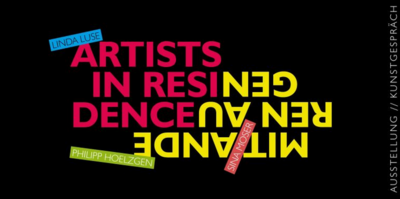Welcome at the Interface Culture program website.
Acting as creative artists and researchers, students learn how to advance the state of the art of current interface technologies and applications. Through interdisciplinary research and team work, they also develop new aspects of interface design including its cultural and social applications. The themes elaborated under the Master's programme in relation to interactive technologies include Interactive Environments, Interactive Art, Ubiquitous Computing, game design, VR and MR environments, Sound Art, Media Art, Web-Art, Software Art, HCI research and interaction design.

The Interface Culture program at the Linz University of Arts Department of Media was founded in 2004 by Christa Sommerer and Laurent Mignonneau. The program teaches students of human-machine interaction to develop innovative interfaces that harness new interface technologies at the confluence of art, research, application and design, and to investigate the cultural and social possibilities of implementing them.
The term "interface" is omnipresent nowadays. Basically, it describes an intersection or linkage between different computer systems that makes use of hardware components and software programs to enable the exchange and transmission of digital information via communications protocols.
However, an interface also describes the hook-up between human and machine, whereby the human qua user undertakes interaction as a means of operating and influencing the software and hardware components of a digital system. An interface thus enables human beings to communicate with digital technologies as well as to generate, receive and exchange data. Examples of interfaces in very widespread use are the mouse-keyboard interface and graphical user interfaces (i.e. desktop metaphors). In recent years, though, we have witnessed rapid developments in the direction of more intuitive and more seamless interface designs; the fields of research that have emerged include ubiquitous computing, intelligent environments, tangible user interfaces, auditory interfaces, VR-based and MR-based interaction, multi-modal interaction (camera-based interaction, voice-driven interaction, gesture-based interaction), robotic interfaces, natural interfaces and artistic and metaphoric interfaces.
Artists in the field of interactive art have been conducting research on human-machine interaction for a number of years now. By means of artistic, intuitive, conceptual, social and critical forms of interaction design, they have shown how digital processes can become essential elements of the artistic process.
Ars Electronica and in particular the Prix Ars Electronica's Interactive Art category launched in 1991 has had a powerful impact on this dialog and played an active role in promoting ongoing development in this field of research.
The Interface Cultures program is based upon this know-how. It is an artistic-scientific course of study to give budding media artists and media theoreticians solid training in creative and innovative interface design. Artistic design in these areas includes interactive art, netart, software art, robotic art, soundart, noiseart, games & storytelling and mobile art, as well as new hybrid fields like genetic art, bioart, spaceart and nanoart.
It is precisely this combination of technical know-how, interdisciplinary research and a creative artistic-scientific approach to a task that makes it possible to develop new, creative interfaces that engender progressive and innovative artistic-creative applications for media art, media design, media research and communication.
Artists-in-Residence-Aufenthalt 2024
Ausstellung bis 9. November 2025 Kunstraum St. Virgil, Ernst-Grein-Straße 14, 5026 Salzburg
Linda Luse & Philipp Hoelzgen
Artists-in-Residence-Aufenthalt 2024
Bereits zum 19. Mal konnten zwei von einer Fachjury ausgewählte Künstler*innen zu diesem Aufenthalt eingeladen werden. Die Künstler*innen Linda Luse (*1987, Gulbene, Lettland) und Philipp Hoelzgen (*1994, Regensburg, Deutschland) arbeiteten im Sommer 2024 im Zuge des Artists-in-Residence-Aufenthaltes für fünf Wochen im Kunstatelier von St. Virgil.
In ihrer neuen Keramik-Serie „Dürre Weiden“ setzt sich Linda Luse mit der fragilen und zunehmend bedrohten Beziehung zwischen menschlichem Handeln und ökologischer Gesundheit auseinander – mit besonderem Fokus auf dem Boden als essenzielle Lebensgrundlage. Ihre Arbeit basiert auf intensiver Recherche und konzeptueller Auseinandersetzung mit den ökologischen Folgen von Eingriffen wie Bodenversiegelung, Umweltverschmutzung und nicht nachhaltiger Landnutzung.
Der Boden – der artenreichste Lebensraum der Erde – wird zur zentralen Metapher in ihrer Arbeit: In seinem komplexen Gefüge aus Mikroorganismen und unterirdischen Netzwerken liegt die Grundlage für Pflanzenwachstum, Nährstoffversorgung und funktionierende Ökosysteme. Doch dieser Raum wird zunehmend degradiert, ausgelaugt und übersehen.
Mit „Dürre Weiden“ schafft Luse eine Installation, die sowohl Verlust als auch Dringlichkeit vermittelt. Ihre kargen, beinahe apokalyptisch wirkenden Keramikskulpturen konfrontieren die Betrachtenden mit der Realität ökologischer Zerstörung. Die Künstlerin ruft dazu auf, unsere Verbindung zum Boden – und damit zum Leben selbst – neu zu überdenken und wertzuschätzen.
Philipp Hoelzgen präsentiert in der Ausstellung neue Arbeiten aus der Serie „Silhouettes of Terraforming“. Ausgangspunkt sind Beobachtungen traditioneller Schindelarchitektur im alpinen Raum, die während seines Aufenthaltes in St. Virgil entstanden sind. Darin untersucht Hoelzgen, wie der Mensch durch bauliche Eingriffe nicht nur seine Umwelt, sondern auch seine soziale Realität formt. Architektur wird dabei nicht nur als funktionales System verstanden, sondern als Ausdruck von Ideologien, Vergänglichkeit und Körperbezug.
Ausgehend von alpinen Schindelhäusern, deren hölzerne Fassaden sich im Lauf der Jahre silbrig verfärben, ist eine Serie fotografischer Skulpturen und „kostümartiger“ Objekte entstanden. Analoges Fotopapier wird dabei zu einem Material, das – ähnlich den Schindeln – auf Licht, Feuchtigkeit und Zeit reagiert. Die entstandenen Arbeiten thematisieren den Übergang zwischen Mensch und Raum, innen und außen, Individuum und Umwelt.
Das Artists-in-Residence-Programm wird von Würth Österreich unterstützt.
Mit Unterstützung für Materialförderung durch Bildrecht Wien.
www.virgil.at/kunstraum/ausstellungen-archiv/linda-luse-philipp-hoelzgen
